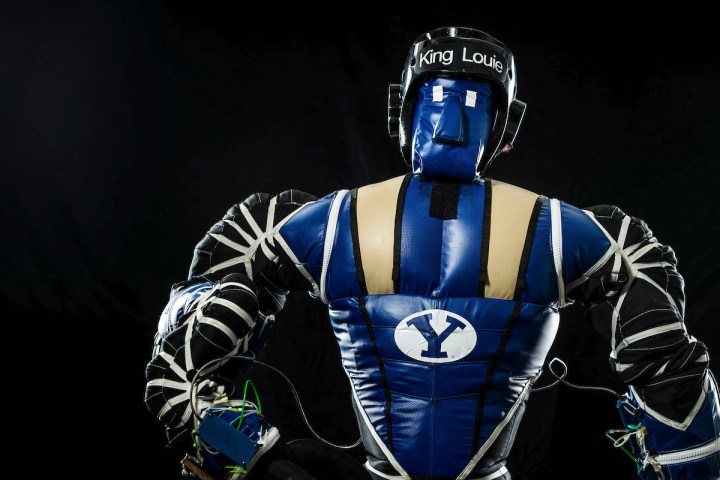
Whether it is serving as helpful Robby the Robot-style assistants to human astronauts or carrying out remote explorations where humans dare not — or simply don’t want to — tread, there are plenty of reasons why robots have a valuable future in space missions. But don’t expect that the bots best suited for a life in the stars will necessarily look like the ones we’re used to seeing here on Earth.
The latest example of this is King Louie (yes, named after the rowdy orangutan from Disney’s 1967 movie The Jungle Book). Developed using funding from NASA, this inflatable creation may appear more like a float from the Macy’s Thanksgiving Day Parade than a state-of-the-art robot, but it’s actually a pretty damn interesting glimpse at the possible future of robotics.

“Robots like King Louie are essentially made up of bags of air, surrounded by a fabric shell that is really strong,” Marc Killpack, a Professor in the Department of Mechanical Engineering at Brigham Young University, who worked on the project, told Digital Trends.
Louie’s movement is controlled by inflating or deflating different chambers in its limbs. For instance, inflating a chamber on the bottom of its arm makes the arm move up. Inflating a chamber on the top makes the arm move back down.
As such, they function in the same antagonistic way as muscle pairs in the human body, where one muscle contracting (say, your bicep) means another one (in this case, the tricep) relaxing. Using only air pumped into the joints, Killpack estimates that the robot’s current payload capacity is equivalent to that of a more traditional robot, like Rethink Robotics’ Baxter robot, for example.
Robots in space
The idea of using an inflatable robot in space makes sense when you consider one of the biggest fundamental challenges of space travel: getting the equipment up into space to begin with. This is why groups like NASA have invested so heavily in research into areas like 3D printing, with the idea that, rather than having to rocket all of their needed equipment into space at a premium cost, it would instead be much easier to print them as and when required.
The King Louie project offers similar promise. NASA hopes that it will be possible to use Louie as an alternative to more traditional robot arms or humanoid robots on rovers, shuttles, and space stations, but without the initial transportation challenges of that equipment. Instead, it can be shipped (make that “rocketed”) to its destination in a deflated state, and then blown up when it’s necessary to get to work.
“Fluid-driven robots can be beneficial because when you release the fluid — air, in this case — the robot can collapse down to much smaller size for storage or transport,” Killpack said.
The lightweight robot design is also useful when you consider that these robots are highly likely to be working alongside either humans or sensitive equipment, often in very cramped environments. As a result, an inflatable robot is considered preferable to a hard one because it does not pose the same physical dangers if there is an unwanted interaction.
More earthbound applications, too
NASA has plenty of configurations in mind when it comes to possible use of the King Louie robot. These could range from a single air-powered robot arm on a rover to a more humanoid creation resembling a Bobo Doll. But the research may well have more earthbound applications, too.

“As we programmed the robot and developed mathematical models to describe how the inflatable soft robots would move, we definitely had space applications in mind,” Killpack said. “However, the more we work with these platforms, the more convinced we become that pretty much any application that requires an automated solution to be in close proximity to people, these robots could be viable candidates given some further refinement and development.”
Some of these possible applications might include in-home assistance, working in hospitals around people, or in search and rescue operations where rescuers could take advantage of their easy portability to transport them to remote, hard-to-reach locations.
“We do not imagine these soft robots necessarily replacing the precision and speed of traditional factory robots, but we do imagine that there are many applications where a large, heavy, dangerous factory robot would not be a good fit and a soft, inflatable robot could perform well,” he said.
For now, King Louie remains a research and development project. Where it goes from here — both physically and in terms of ongoing research on the project — remains to be seen. Nonetheless, it is great to see that all parties working on this initiative are exploring new and exciting technological trends which promise to make soft robots more useful than ever.
Here at Digital Trends, we’re happy to say that we’re keen to welcome our new inflatable space robot overlords. Long may they remain free from punctures!


